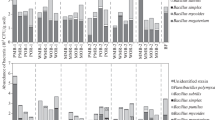Abstract
The extent of decline in the population density of Rhizobium sp. exposed to Bdellovibrio was markedly reduced in the presence of montmorillonite, kaolinite or vermiculite but not by a soil clay fraction. Increasing levels of montmorillonite reduced the numbers of vibrios that appeared in a two-membered culture and allowed for greater survival of the rhizobia. Bdellovibrio and not Rhizobium sp. was retained when mixed with the three clay minerals, but no appreciable retention was evident with the soil clay fraction. Suspensions of colloidal soil organic matter protected the hosts from parasitism, although aqueous extracts of soil did not affect the relationship. Cells from old Rhizobium sp. cultures were attacked only after a lag phase, but rhizobia that had been stored were more rapidly lysed than cells tested immediately after removal from the growth medium. The possible significance of these findings to the survival of rhizobia in soils containing Bdellovibrio is discussed.
Similar content being viewed by others
References
Chatel, D.L., Parker, C.A.: Inhibition of rhizobia by toxic soil-water extracts. Soil Biol. Biochem. 4, 289–294 (1972)
Danso, S.K.A., Habte, M., Alexander, M.: Estimating the density of individual bacterial populations introduced into natural ecosystems. Canad. J. Microbiol. 19, 1450–1451 (1973)
Marshall, K.C.: Electrophoretic properties of fast- and slow-growing species of Rhizobium. Aust. J. biol. Sci. 20, 429–438 (1967)
Marshall, K.C.: The nature of bacterium-clay interactions and its significance in survival of Rhizobium under arid conditions. Trans. Int. Congr. Soil Sci., Adelaide 3, 275–280 (1968)
Parker, C.A., Grove, P.L.: Bdellovibrio bacteriovorus parasitizing Rhizobium in Western Australia. J. appl. Bact. 33, 253–255 (1970)
Starr, M.P., Huang, J.C.-C.: Physiology of the bdellovibrios. Advanc. Microbial Physiol. 8, 215–261 (1972)
Stolp, H., Starr, M.P.: Bdellovibrio bacteriovorus gen. et. sp. n., a predatory, ectoparasitic, and bacteriolytic microorganism. Antonie v. Leeuwenhoek 29, 217–248 (1963)
Stotzky, G.: Clay minerals and microbial ecology. Trans. N.Y. Acad. Sci. 30, 11–21 (1967)
Stotzky, G.: Techniques to study interactions between microorganisms and clay minerals in vivo and in vitro. Bull. Ecol. Res. Comm. (Stockh.) 17, 17–28 (1973)
Van Schreven, D.A.: Some factors affecting growth and survival of Rhizobium spp. in soil-peat cultures. Plant and Soil 32, 113–130 (1970)
Author information
Authors and Affiliations
Rights and permissions
About this article
Cite this article
Keya, S.O., Alexander, M. Factors affecting growth of Bdellovibrio on Rhizobium . Arch. Microbiol. 103, 37–43 (1975). https://doi.org/10.1007/BF00436327
Received:
Issue Date:
DOI: https://doi.org/10.1007/BF00436327




